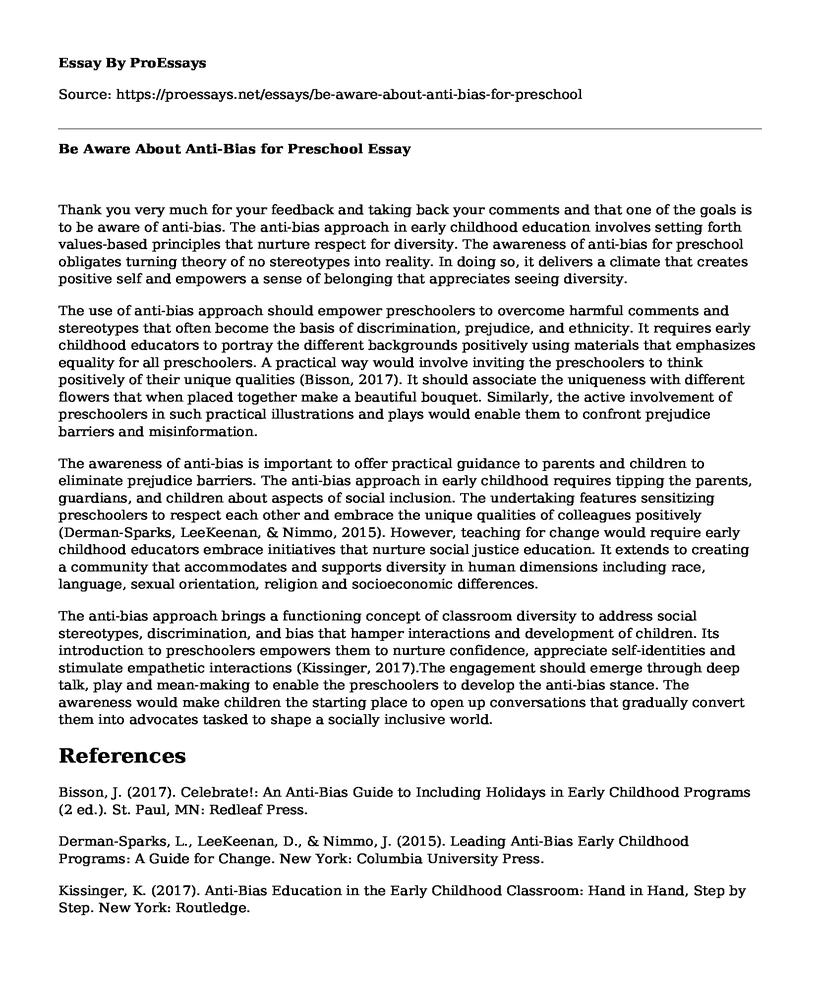Thank you very much for your feedback and taking back your comments and that one of the goals is to be aware of anti-bias. The anti-bias approach in early childhood education involves setting forth values-based principles that nurture respect for diversity. The awareness of anti-bias for preschool obligates turning theory of no stereotypes into reality. In doing so, it delivers a climate that creates positive self and empowers a sense of belonging that appreciates seeing diversity.
The use of anti-bias approach should empower preschoolers to overcome harmful comments and stereotypes that often become the basis of discrimination, prejudice, and ethnicity. It requires early childhood educators to portray the different backgrounds positively using materials that emphasizes equality for all preschoolers. A practical way would involve inviting the preschoolers to think positively of their unique qualities (Bisson, 2017). It should associate the uniqueness with different flowers that when placed together make a beautiful bouquet. Similarly, the active involvement of preschoolers in such practical illustrations and plays would enable them to confront prejudice barriers and misinformation.
The awareness of anti-bias is important to offer practical guidance to parents and children to eliminate prejudice barriers. The anti-bias approach in early childhood requires tipping the parents, guardians, and children about aspects of social inclusion. The undertaking features sensitizing preschoolers to respect each other and embrace the unique qualities of colleagues positively (Derman-Sparks, LeeKeenan, & Nimmo, 2015). However, teaching for change would require early childhood educators embrace initiatives that nurture social justice education. It extends to creating a community that accommodates and supports diversity in human dimensions including race, language, sexual orientation, religion and socioeconomic differences.
The anti-bias approach brings a functioning concept of classroom diversity to address social stereotypes, discrimination, and bias that hamper interactions and development of children. Its introduction to preschoolers empowers them to nurture confidence, appreciate self-identities and stimulate empathetic interactions (Kissinger, 2017).The engagement should emerge through deep talk, play and mean-making to enable the preschoolers to develop the anti-bias stance. The awareness would make children the starting place to open up conversations that gradually convert them into advocates tasked to shape a socially inclusive world.
References
Bisson, J. (2017). Celebrate!: An Anti-Bias Guide to Including Holidays in Early Childhood Programs (2 ed.). St. Paul, MN: Redleaf Press.
Derman-Sparks, L., LeeKeenan, D., & Nimmo, J. (2015). Leading Anti-Bias Early Childhood Programs: A Guide for Change. New York: Columbia University Press.
Kissinger, K. (2017). Anti-Bias Education in the Early Childhood Classroom: Hand in Hand, Step by Step. New York: Routledge.
Cite this page
Be Aware About Anti-Bias for Preschool. (2022, Apr 04). Retrieved from https://proessays.net/essays/be-aware-about-anti-bias-for-preschool
If you are the original author of this essay and no longer wish to have it published on the ProEssays website, please click below to request its removal:
- Essay on Impact of Social Media on College Students
- Critical Reading of John Gatto's Article "Against School"
- Role of Terrorism in Homeland Security Paper Example
- Essay on Different Cultural Constructions of Childhood
- Multisensory Teaching: An Effective Method for Learning Difficulties - Essay Sample
- Essay Sample on Gamification: Enhancing Learning with Fun and Excitement
- Columbia Southern University Policy - Essay Example







